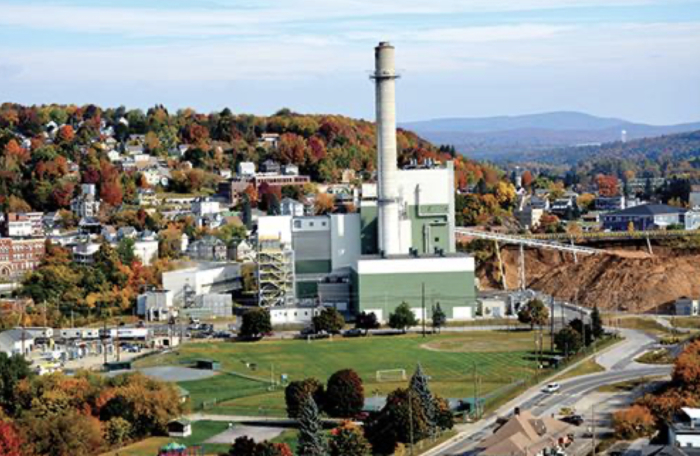How would you feel about being taxed to support a failing business in a city on the other side of the state?
If you’d be fine with that, well, good news!
Under the guise of promoting “renewable energy,” many Granite Staters are subsidizing a single business in Berlin. That subsidy could come to an end this year, depending on how the governor responds to a bill now on his desk.
The business in question is the Burgess Biopower plant, which is not actually a viable power plant. Rather, it’s a subsidized jobs program for the Northern New England timber industry, disguised as a power plant.
Burning wood is an inefficient and expensive way to generate electricity. Natural gas, more energy dense than wood, is a better fuel source, which is why natural gas accounts for 40% of U.S. electricity generation while biomass accounts for just 1.3%. (Nuclear is also better.)
Electric utilities generally don’t buy power generated from wood, and most people no longer heat with wood. What to do with low-grade wood products, then? Politicians had an idea. Rig the market to favor this inefficient fuel source (and others).
In New Hampshire, politicians years ago came up with a scheme to transfer cash from Granite State residents to politically favored energy interests, including the timber industry. The plan was to make utilities buy power from “renewable” sources, regardless of cost. The state would create an artificial market for “renewable” energy by compelling utilities to buy from a list of government-approved energy sources. Among them was biomass.
In 2006, Gov. John Lynch pushed for a law requiring 25% of the state’s energy to come from “renewable” sources by 2025. In 2007, the Legislature passed and Gov. Lynch enthusiastically signed a Renewable Portfolio Standard law requiring electricity providers to purchase power from “renewable” resources in increasing percentages through 2025, or purchase certificates representing renewable energy generated from an approved source.
This law prompted the state’s largest utility, Public Service of New Hampshire (PSNH, now Eversource) to pursue a deal to buy electricity from qualifying sources, event at above-market rates.
In 2011, PSNH petitioned the state’s Public Utilities Commission to approve a power purchase agreement the utility had signed with a company that promised to build a biomass power plant in Berlin.
The first point in PSNH’s petition to the PUC was that the purchase agreement would help the utility satisfy the RPS mandates.
“Pursuant to RSA Chapter 362-F, the Electric Renewable Portfolio Standard (“RPS”), PSNH must obtain and retire certificates (“RECs”) sufficient in number and class type to meet or exceed specified annual percentages of total megawatt-hours of electricity supplied by it to its Energy Service customers. To partially comply with this statutory requirement, PSNH has entered into a Power Purchase Agreement (“PPA”) with LLB regarding LLB’s proposed 70 MW (gross) biomass fueled generating station in Berlin, New Hampshire (the “Project”), to purchase the RECs produced by the Project, as well as the energy and capacity produced from the Project.”
The PUC approved the agreement, despite projections that it would cost ratepayers $125 million more than they would otherwise pay for power, and despite objections from the state’s Office of Consumer Advocate.
Ratepayers’ above-market costs were supposed to have been capped at $100 million. In 2018, legislators passed and Gov. Chris Sununu signed a law that suspended the cap for three years. Ratepayer overpayments exceeded the $100 million cap in 2019. At the end of the suspension, Burgess was supposed to repay $58 million in overpayments.
But in 2022 legislators again passed a bill granting a temporary reprieve.
From the Burgess plant’s opening in 2014 through the end of 2021, the PUC-approved agreement cost New Hampshire ratepayers more than $150 million.
Now, with no end of ratepayer subsidies in sight, legislators have passed yet another bill to keep the gravy train running.
This one, House Bill 142, forgives the more than $50 million in overpayments Burgess is supposed to repay, directs the Public Utility Commission to expedite any docket item related to the Burgess plant, and writes into law the presumption that any “relief provided to the Burgess Biopower plant by the restoration of the terms of the original PPA shall be deemed to be reasonable, legitimate, and in the public interest for the purposes of RSA 374:57, or any provision of law applicable to the approval of power purchase agreements.”
In other words, it stacks the deck at the PUC in favor of Burgess Biopower and against consumers.
The terms of HB 142 would prove so costly that the Business and Industry Association and the Sierra Club both argued against its passage. The BIA has asked Gov. Sununu to veto the bill, citing the “significant additional expense on the energy bills of commercial and industrial ratepayers.”
Boosters of the plant claim that its subsidies are necessary because the plant supports 240 jobs, making it a “major economic catalyst” for the state.
In fact, the plant employs fewer than 30 people, or about as many as a large Dunkin’ Donuts franchise. There are two restaurants in Berlin that employ nearly as many people as the power plant, according to state employment data.
The additional 210+ jobs the plant “supports” are jobs in the timber and related industries. For context, that’s about as many people as work at a large Walmart super center, or a Walmart plus a small business or two in the strip mall it inhabits.
The Burgess Biopower plant is in no way a “major economic catalyst” for the state. It’s a large taxpayer in Berlin, but that makes it an important local business, not an important player in the state’s overall economy.
The plant’s biggest economic contribution to the New Hampshire economy is to suck money from Eversource’s coverage area and redistribute it to an otherwise unprofitable power plant owned by a private equity firm, as well as to a few hundred people (at best) in the timber industry throughout Northern New England and Canada. (Only about half of the wood purchased by the plant is from New Hampshire.)
If HB 142 becomes law, more than $50 million ratepayers overpaid to subsidize this plant, and which are supposed to be returned to ratepayers, will be forgiven.
New Hampshire has among the highest electricity rates in the United States. This discourages business investment in the Granite State, particularly in manufacturing. Lowering those costs would improve New Hampshire’s economic outlook. Forgiving ratepayer subsidies for a single small business in Berlin would do the opposite.
The state shouldn’t subsidize private businesses. If legislators really believe it’s in the public interest for Granite Staters to be compelled to support a biomass plant, they could make the case for writing such a subsidy into the state budget. Doing it through an elaborate scheme that pushes electric utility rates higher is less transparent and more economically damaging.
Editor’s note: HB 142 would eliminate Burgess Biopower’s obligation to repay consumers for more than $50 million in overpayments made to the plant. An early version of this story indicated that the overpayments would continue indefinitely.









